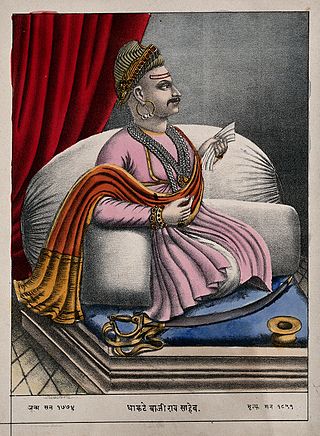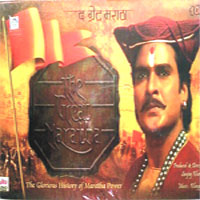
Peshwa was second highest office in the Maratha Confederacy, next in rank and prestige only to that of the Chhatrapati. Initially serving as the appointed prime minister in the Maratha Kingdom, the office became hereditary after the death of Shahu in 1749. During the reign of Shahu, the office of Peshwa grew in power and the Peshwas came to be the de facto rulers of the Maratha Confederacy. However following the defeat of the Marathas in 1761, the office of the Peshwa became titular as well and from that point onwards served as the ceremonial head of the Confederacy underneath the Chhatrapati.

Shaniwar Wada is a historical fortification in the city of Pune, India. Built in 1732, it was the great seat of the Peshwas of the Maratha Empire until 1818. Following the rise of the Maratha Empire, the palace became the center of Indian politics in the 18th century. The fort itself was largely destroyed in 1828 by an unexplained fire, but the surviving structures are now maintained as a tourist site.

Balaji Baji Rao, often referred to as Nana Saheb I, was the 8th Peshwa of the Maratha Confederacy. He was appointed as Peshwa in 1740 upon the death of his father, the Peshwa Bajirao I.

Madhavrao I was the son of Peshwa Balaji Bajirao and grandson of Peshwa Bajirao I who served as 9th Peshwa of the Maratha Confederacy. During his tenure, the Maratha Confederacy recovered from the losses they suffered during the Third Battle of Panipat, an event known as Maratha Resurrection.

Narayanrao was the 10th Peshwa of the Maratha Confederacy from November 1772 until his assassination in August 1773. He married Gangabai Sathe who later gave birth to Sawai Madhavrao.

Baji Rao II was the 13th and the last Peshwa of the Maratha Confederacy. He governed from 1795 to 1818. He was installed as a puppet ruler by the Maratha nobles, whose growing power prompted him to flee his capital Poona and sign the Treaty of Bassein (1802) with the British. This resulted in the Second Anglo-Maratha War (1803–1805), in which the British emerged victorious and re-installed him as the titular Peshwa. In 1817, Baji Rao II joined the Third Anglo-Maratha War against the British, after they favoured the Gaekwad nobles in a revenue-sharing dispute. After suffering several battle defeats, the Peshwa surrendered to the British, and agreed to retire in return for an estate at Bithoor and an annual pension.

Nana Fadnavis, born Balaji Janardan Bhanu, was a Maratha minister and statesman during the Peshwa administration in Pune, India. James Grant Duff states that he was called "the Maratha Machiavelli" by the Europeans.

Maharani Tarabai Bhosale (née Mohite) was the regent of the Maratha Kingdom from 1700 until 1708. She was the queen of Rajaram I, and daughter-in-law of the kingdom'd founder Shivaji I. She is acclaimed for her role in keeping alive the resistance against Mughal rule in Konkan, and acting as the regent during the minority of her son, Shivaji II and defeated Aurangazeb

Raghunathrao Bhat, also known as Ragho Ballad or Raghoba Dada, was the younger son of Peshwa Bajirao I who served as the 11th Peshwa of the Maratha Confederacy for a brief period from 1773 to 1774.

Madhavrao II was the 12th Peshwa of the Maratha Confederacy, from his infancy. He was known as Sawai Madhav Rao or Madhav Rao Narayan. He was the posthumous son of Narayanrao Peshwa, murdered in 1773 on the orders of Raghunathrao. Madhavrao II was considered the legal heir, and was installed as Peshwa by the Treaty of Salbai in 1782 after First Anglo-Maratha War.
Gopikabai was Peshwin of Maratha Empire, as the wife of Peshwa Balaji Baji Rao. She had a very orthodox religious upbringing and belief. After the death of Nanasaheb Peshwa, she tried to expand her power over the Peshwa and the administration. She influenced her son Madhavrao Peshwa, who by sidelining Raghunathrao at her urging, assumed control. However, after trying to interfere in administrative matters, namely to save her brother from punishment, she was confined to Nashik. In 1773 she was freed after the death of Madhavarao and went back to Pune. Afterwards, Gopikabai became part of the priestly class. She developed a rivalry with other women in the Peshwa's household. She was the mother of three successive Peshwas.
Visaji Krushna Chinchalkar, popularly known as Visaji Pant Biniwale, was one of the leading generals of Peshwas in Northern India during 1759 to 1772. Peshwa Madhavrao I mainly sought his assistance in his attempt to restore Maratha Empire in the North after the defeat in the Battle of Panipat (1761).
Menavli is a village about three kilometres from Wai in the Satara district. The village's claim to fame is due to the palace (wada) built by Nana Fadnavis, 18th century Maratha statesman and the regent of Peshwa Madhavrao II.
Umabai Dabhade was a prominent member of the Maratha Dabhade clan. The members of her family held the hereditary title senapati (commander-in-chief), and controlled several territories in Gujarat. After the deaths of her husband Khande Rao and her son Trimbak Rao, she exercised executive powers while her minor son Yashwant Rao remained the titular senapati. Her unsuccessful rebellion against Peshwa Balaji Baji Rao resulted in the downfall of the Dabhade family.
Baloji Kunjar / Kunjir (17??–1816) was Sardar and Minister of Affairs in service of Peshwa Baji Rao II. He was Peshwa Baji Rao II's favorite. After the death of Peshwa Sawai Madhavrao, there was debates for the position of Peshwa among the Maratha Empire. Balaji Kunjar performed a successful role to convey most friendly declaration and assurance between Baji Rao II and Nana Phadanvis, to appoint Baji Rao II as peshwa of Maratha Empire. Peshwa Baji Rao II and Nana Phadanvis awarded inam (Jagir) to him in 14 villages near Purandhar fort, for his role. He performed successful role in administration of maratha empire and as affairs minister or diplomat (vakil) for Peshwa Baji Rao II. He along with his son Pandoji Kunjar and Narayan, enjoyed the position as Sur-Patil (सर-पाटील) at Pune Punch Mahals during the era of Peshawa Baji Rao II. He along with his family has long enjoyed the privileges of sar-patil of 360 villages and towns in the Subha of Poona.

The Great Maratha is an Indian historical drama television series directed by Sanjay Khan and produced by Numero Uno International Limited. The drama aired on DD National. The series is based on the life of Mahadaji Shinde. The show comprised 47 episodes. The music was composed by Mohammed Zahur Khayyam.
The Bhat Peshwa family earlier known as Bhat family is a prominent Indian Chitpavan Brahmin family who dominated India for around 100 years in the late 18th century and early 19th century. Most of the members in this family were the Peshwas in the Peshwa Era of the Maratha Empire, and Peshwa later became their family name. During their regime, most of the Indian subcontinent was under their control. The last Peshwa, Baji Rao II, was defeated by the British East India Company in the Third Anglo-Maratha War in 1818. The territory was annexed to the British East India Company's Bombay Presidency, and he was pensioned.
Sakharam Hari Gupte was born in Chandraseniya Kayastha Prabhu (CKP) family, and was the commander and tipnis (secretary) of Peshwa Bajirao I. For few years he worked under Peshwa Nanasaheb and then became the General of Raghunathrao Peshwa. He was responsible for conquering Attock on the banks of the Indus and repelling the Durrani ruler, Ahmad Shah Abdali out of India in the 1750s.
Sumer Singh Gardi was a Gardi guard of the Peshwas. He is mainly known for his involvement in the assassination of Peshwa Narayanrao in 1773, where he led several Gardis and brutally killed Narayanrao. The assassination was performed on the orders of Raghunathrao, whose message was intercepted by his wife Anandibai.

The Assassination of Narayan Rao occurred on 30 August 1773, when the 18 year old Peshwa of the Maratha Confederacy Narayan Rao, was assassinated. This plot was carried out During the Ganesh Chaturthi Festival that took place from 21 to 31 August. This was plotted by his uncle Raghunath Rao and his wife Anandibai. They used members of the Kalbelia tribe as assassins. Raghunath Rao was the next in line for the throne, at the time of Narayan Rao's death. Narayan Rao and his servant Chapaji Tilekar were both killed. A total of eleven people had been killed in the palace, seven of them were Brahmins, two servants, two maids. One cow was also killed.












